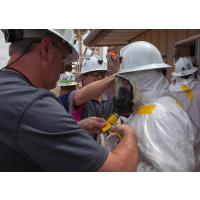Source of Radioactive Leak in Nation’s Only Nuclear Weapons Waste Storage Facility Remains Unsolved
 On April 2, 2014, workers prepare to enter the Waste Isolation Pilot Plant facility in Carlsbad, N.M., for the first time since the Feb. 14 radiological release (photo: Department of Energy)
On April 2, 2014, workers prepare to enter the Waste Isolation Pilot Plant facility in Carlsbad, N.M., for the first time since the Feb. 14 radiological release (photo: Department of Energy)
Government officials still can’t say for certain what caused the leak of radioactivity more than three months ago in New Mexico at the nation’s only underground nuclear weapons waste storage site. But some officials say kitty litter may have been the culprit.
On February 14, operators of the Waste Isolation Pilot Plant (WIPP) in Carlsbad got an unwelcome Valentine when an undisclosed amount of plutonium breached a sealed container buried deep beneath the earth.
The leak contaminated 22 WIPP workers with low levels of radiation and was serious enough for officials to close the facility while investigators determine what caused it.
The Department of Energy, which oversees all nuclear weapons facilities and operations, says some of the containers located half a mile underground may have been packaged improperly before being delivered to the WIPP for storage. And by improperly packaged, they mean someone used the “wrong” kitty litter during the process. Mineral-based cat box filler is used to absorb moisture and stabilize materials inside containers of nuclear waste before they’re sealed.
James Conca, a veteran scientist specializing in the disposal of nuclear waste, wrote in Forbes: “Unfortunately, someone working with this waste, before it was to be shipped to WIPP, used a new ‘green’ cat litter, made with materials like wheat or corn. These organic litters do not have the silicate properties needed to chemically stabilize nitrate the correct way.”
The February leak may have come from just one container inside the WIPP. But New Mexico officials aren’t taking any chances and have ordered the federal facility to conduct an “expedited closure” of storage areas that have hundreds of other containers.
But as William Boardman of Reader Supported News points out: “It is unlikely entombment can be achieved for months, at least, since WIPP workers have little safe access to the storage areas yet.”
In the meantime, WIPP’s shutdown is causing problems for Los Alamos National Laboratory (LANL), from which the suspect container originated. LANL has other waste-bearing containers at its site that must be moved by June 30. WIPP is supposed to receive these shipments, but can’t bury them until the problems stemming from the leak are resolved.
Some LANL waste is stored above ground at WIPP, while some was sent to a facility in Texas, where it’s also stored above ground and vulnerable to natural or man-made threats.
-Noel Brinkerhoff
To Learn More:
Radiation Release From Federal Facility Still Stymies Experts (by William Boardman, Reader Supported News)
New Mexico Says 57 Nuke Waste Containers from Los Alamos Could Present Radiation Threat (by Jeri Clausing, Associated Press)
State Orders Closure of Contaminated WIPP Areas (by Patrick Malone, New Mexican)
State: WIPP Must Permanently Close Underground Panels Affected by Radiation Leak (by Zack Ponce, Alamogordo News)
As Hanford Radioactive Leak Continues, Clean-Up Contractor Pays Fraud Penalty (by Noel Brinkerhoff, AllGov)
Nuclear Waste Costing Taxpayers Billions (by Noel Brinkerhoff, AllGov)
- Top Stories
- Unusual News
- Where is the Money Going?
- Controversies
- U.S. and the World
- Appointments and Resignations
- Latest News
- Trump to Stop Deportations If…
- Trump Denounces World Series
- What If China Invaded the United States?
- Donald Trump Has a Mental Health Problem and It Has a Name
- Trump Goes on Renaming Frenzy






Comments